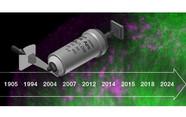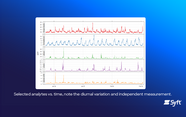High Hopes for High Resolution
Then & Now, with Amadeo Fernández-Alba, Professor at the University of Almeria, Spain.
sponsored by Thermo Fisher Scientific
Then: one sunny day in 2006...
Ten years ago, we started working with accurate mass, high-resolution mass spectrometry (MS). It was one of the first times such an instrument – a liquid chromatography-time-of-flight (TOF) MS system – had been introduced into a routine laboratory for pesticide residue analysis. I have to say, it was really exciting to see how we could detect and identify a compound simply by inputting its molecular weight or identify new compounds by comparing molecular weights with a database – a great prospect for food safety, as we could detect banned pesticides for which there were no analytical standards. I was truly enthusiastic about the new capabilities.
Unfortunately, every silver lining has a cloud... Credible quantitation on the new system was not possible in many cases – and in pesticide residue analysis, reliable quantification is essential. As a consequence, our conclusion on that time was that accurate-mass, high-resolution MS could only really become a complementary technique (to triple-quadrupole instruments) in food safety analysis; for example, when we had only one transition on the triple-quads for specific compounds or if there was a very strong co-elution of matrix with an isobaric transition.
We had a new tool – but it wasn’t quite the revolution I was hoping for. There was a dark side!
Now: June 2, 2016
Over the last ten years, the situation has changed and technology has improved tremendously – and improvements to system software have also been pivotal. Today, good sensitivity, good linearity and good reproducibility – coupled to incredible resolution and excellent mass accuracy (the Q Exactive™ Focus Hybrid Quadrupole-Orbitrap™ Mass Spectrometer provides a resolving power of 70,000 at m/z 200 in full-scan mode and 1 ppm mass accuracy) mean that HRAM platforms have developed from a complementary technique to the technique of choice. And that’s not a statement I make lightly. I am sure we will see more incremental improvements in the future, but we’ve already reached the point where identification capabilities are higher in HRAM instruments, and where quantitation is comparable for pesticide residues in food. It’s true that the sensitivity can be a little lower than the newest triple quadrupole systems – but it is high enough. And after thousands of samples, I can state that the robustness is excellent.
In addition, new identification options are open to laboratories: we can now analyze samples in a retrospective way to detect, identify and quantify new unexpected compounds – even without analytical standards.
In reality, the requirement for HRAM MS systems (LC or GC) will depend on the objectives of each lab. But as labs disappear and those that remain become bigger, we can expect that the scope of the analytical challenge (which covers hundreds of different commodities) will only grow. Moreover, an increasing number of target compounds (and an awareness of untargeted contaminants) in increasingly complex matrices is a clear trend; being able to efficiently cope in this new world will become a real differentiator for routine labs.
Right now, I would guess that around 10 percent of labs in my field have adopted HRAM technology. But in 5–10 years, I believe that HRAM-MS will be highly popular, perhaps even outnumbering triple-quadrupole instruments. New concepts always take time to catch on – and for Orbitrap technology, GC was the missing link; laboratories were perhaps wary of switching over to a new concept of analysis for LC but not for GC. With the introduction of the Thermo Scientific™ Q Exactive™ GC Orbitrap™ GC-MS/MS system, the situation has changed.
Our primary driver is to protect consumers, so we must always strive to achieve the best possible pesticide residue control in food. The advanced capability of HRAM-MS systems, such as those based on Orbitrap technology, represent a very important step in that direction.

Rich Whitworth completed his studies in medical biochemistry at the University of Leicester, UK, in 1998. To cut a long story short, he escaped to Tokyo to spend five years working for the largest English language publisher in Japan. "Carving out a career in the megalopolis that is Tokyo changed my outlook forever. When seeing life through such a kaleidoscopic lens, it's hard not to get truly caught up in the moment." On returning to the UK, after a few false starts with grey, corporate publishers, Rich was snapped up by Texere Publishing, where he spearheaded the editorial development of The Analytical Scientist. "I feel honored to be part of the close-knit team that forged The Analytical Scientist – we've created a very fresh and forward-thinking publication." Rich is now also Content Director of Texere Publishing, the company behind The Analytical Scientist.

















